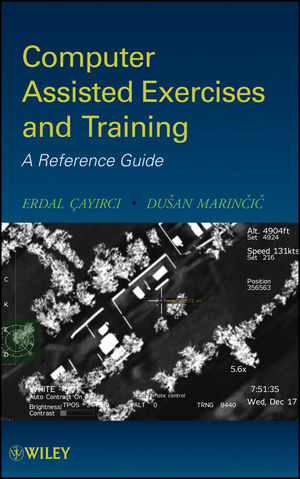Computer Assisted Exercises and Training: A Reference GuideISBN: 978-0-470-41229-9
Hardcover
312 pages
August 2009, Wiley-Blackwell
 This is a Print-on-Demand title. It will be printed specifically to fill your order. Please allow an additional 10-15 days delivery time. The book is not returnable.
|
||||||
ABOUT AUTHORS.
PART I FUNDAMENTALS AND THEORY.
1 Introduction.
1.1 Contemporary Security Environment.
1.2 Exercises.
1.3 Military Simulation.
1.4 Scope of the Book.
1.5 Structure of the Book.
1.6 Electronic Resources for the Book.
1.7 Review Questions.
2 Conflict and Warfare.
2.1 Paradigms of War.
2.2 Evolution of Warfare.
2.3 Operations.
2.4 Comprehensive Approach to Operations.
2.5 Review Questions.
3 Statistics and Probability.
3.1 Descriptive Statistics: Population, Sample, Central Tendency, and Dispersion.
3.2 Probability.
3.3 Random Variable.
3.4 Inferential Statistics.
3.5 Review Questions.
4 Simulation.
4.1 Pseudorandom Number Generation and Realization of Random Variables.
4.2 Static Simulation.
4.3 Dynamic Simulation.
4.4 Phases in a Simulation.
4.5 Review Questions.
5 Distributed Simulation.
5.1 Distributed Interactive Simulation.
5.2 High-Level Architecture.
5.3 Base Object Model (BOM).
5.4 Review Questions.
6 Experimentation and Analysis.
6.1 Design of Experiment.
6.2 Execution of Experiments.
6.3 Data Analysis, Reporting, and Presentation.
6.4 Review Questions.
PART II COMBAT MODELING, COMPUTER-ASSISTED EXERCISES, AND PRACTICE.
7 Computer-Assisted Exercise (CAX) Architectures.
7.1 Distributed Exercises and Distributed Simulation.
7.2 Multilevel and Multiresolution Exercises.
7.3 Cross-Level, Joint, and Combined Exercises.
7.4 Excon Structure.
7.5 Response Cells.
7.6 Training Audience.
7.7 Review Questions.
8 CAX PROCESS.
8.1 Exercise Specification.
8.2 Planning and Preparation.
8.3 Execution.
8.4 Analysis.
8.5 Review Questions.
9 Combat Modeling.
9.1 Terrain Modeling.
9.2 Attrition and Movement.
9.3 Challenges in the Quantification for Nonkinetic Warfare.
9.4 Automated Forces.
9.5 Challenges and Approaches in the Implementation.
9.6 Combat Model Data.
9.7 Verification and Validation of Combat Models.
9.8 Experimentation and Analysis of Operational Plans.
9.9 Review Questions.
10 Computer-Assisted Exercise Support Tools.
10.1 Military Constructive Simulations and Ancillary Tools.
10.2 Planning and Management Tools.
10.3 Mediation-Ware.
10.4 Review Questions.
11 Communications/Information System Issues, Technical Risks, and Risk Mitigation.
11.1 Hardware and Software Requirements.
11.2 Communications and QoS Requirements.
11.3 Security Issues and Challenges.
11.4 Game Crashes, Checkpoints, and Crash Recovery.
11.5 Shadow/Run Ahead Games.
11.6 Backups and Archives.
11.7 Networking Service Outages and Other Reasons for Failure.
11.8 Review Questions.
12 Exercise Centers and Facilities.
12.1 Organization of a Training/Exercise Center.
12.2 Design Principles for Training/Exercise Center Facilities.
12.3 Review Question.
REFERENCES.
ACRONYMS.
INDEX.



